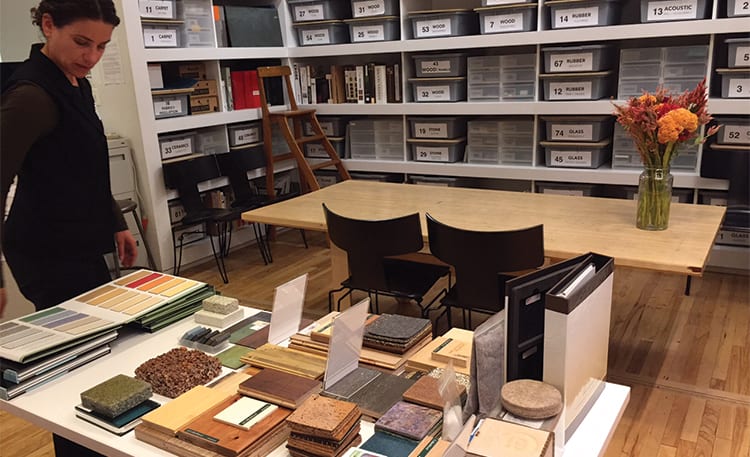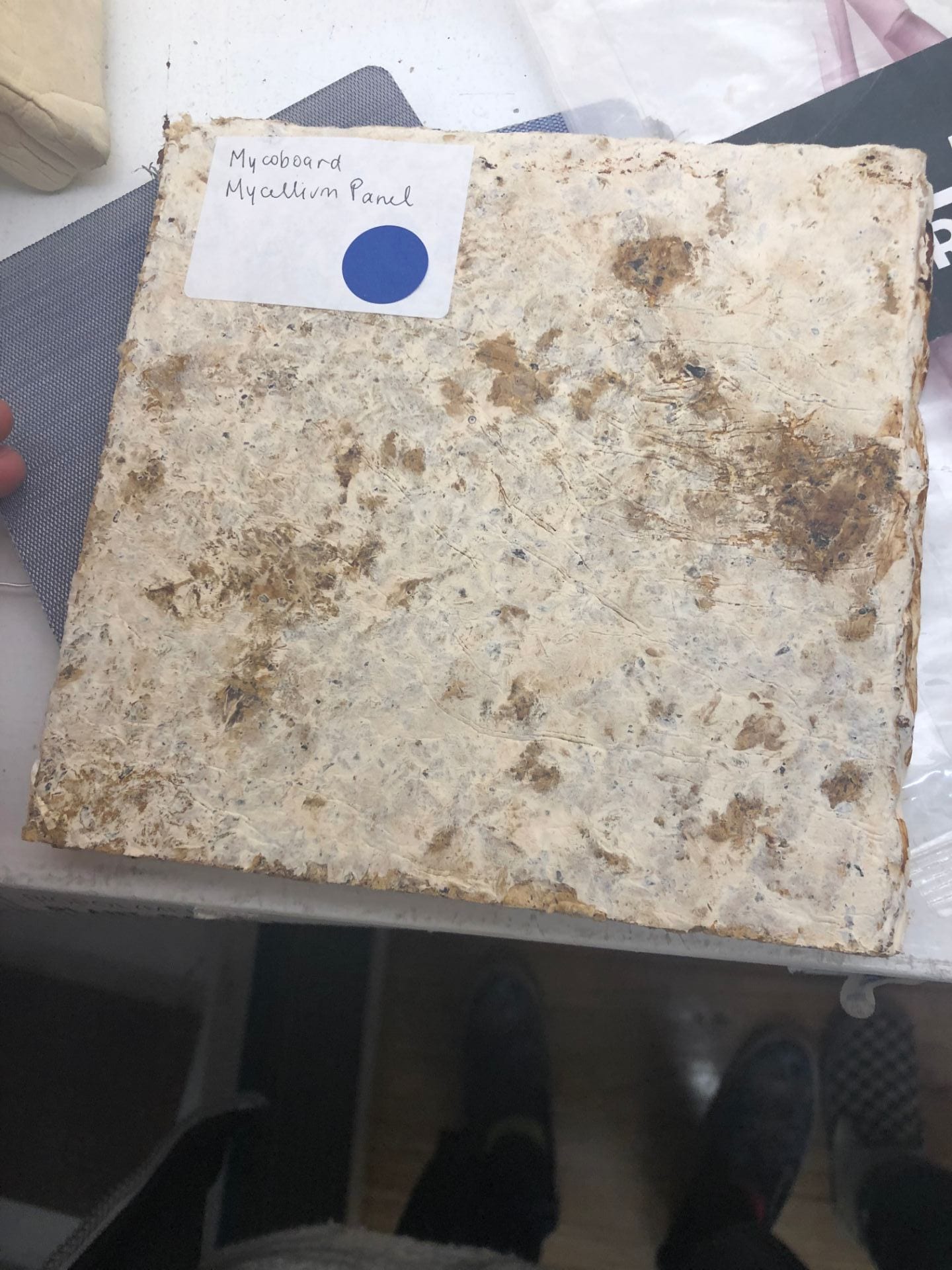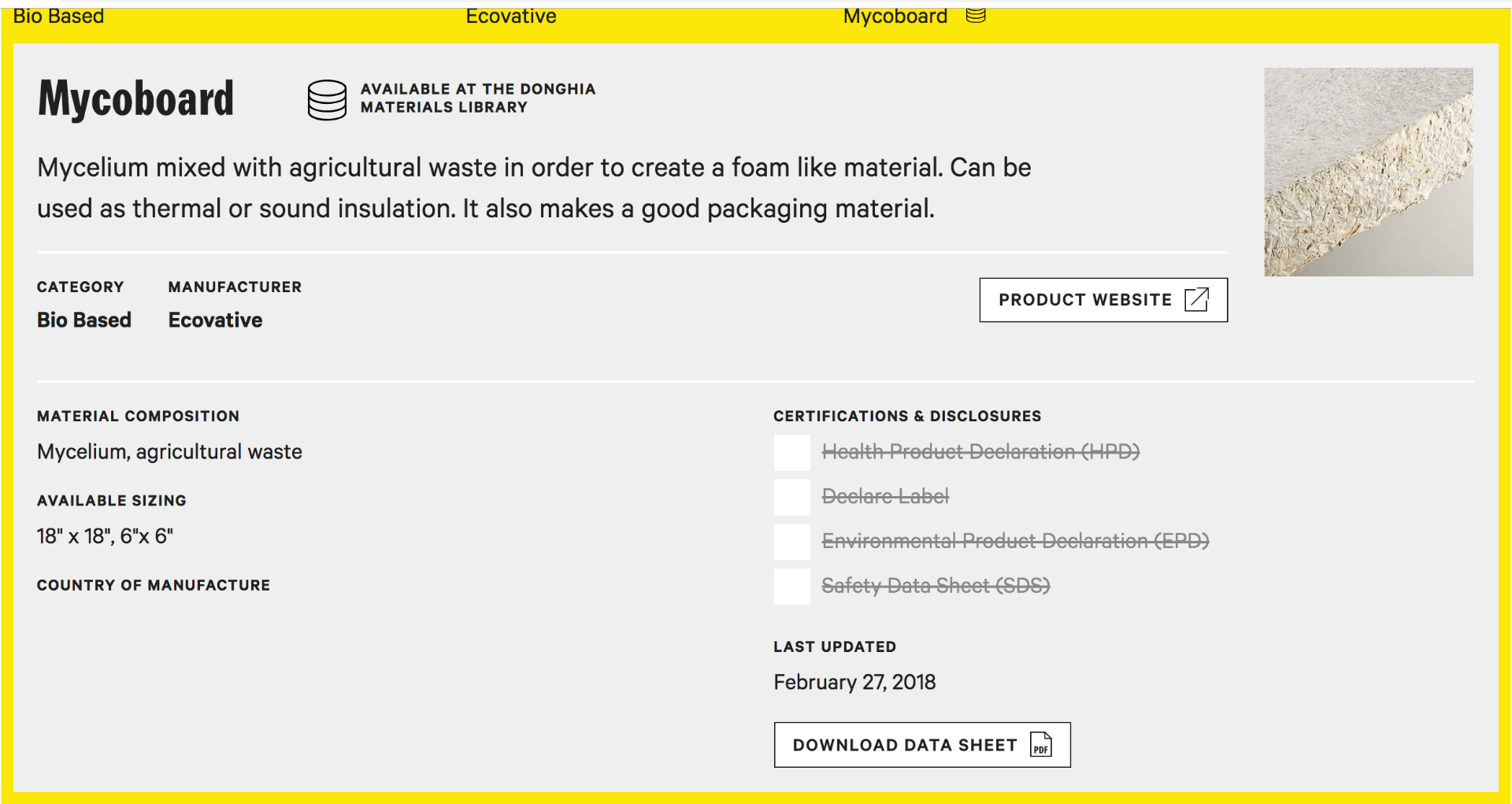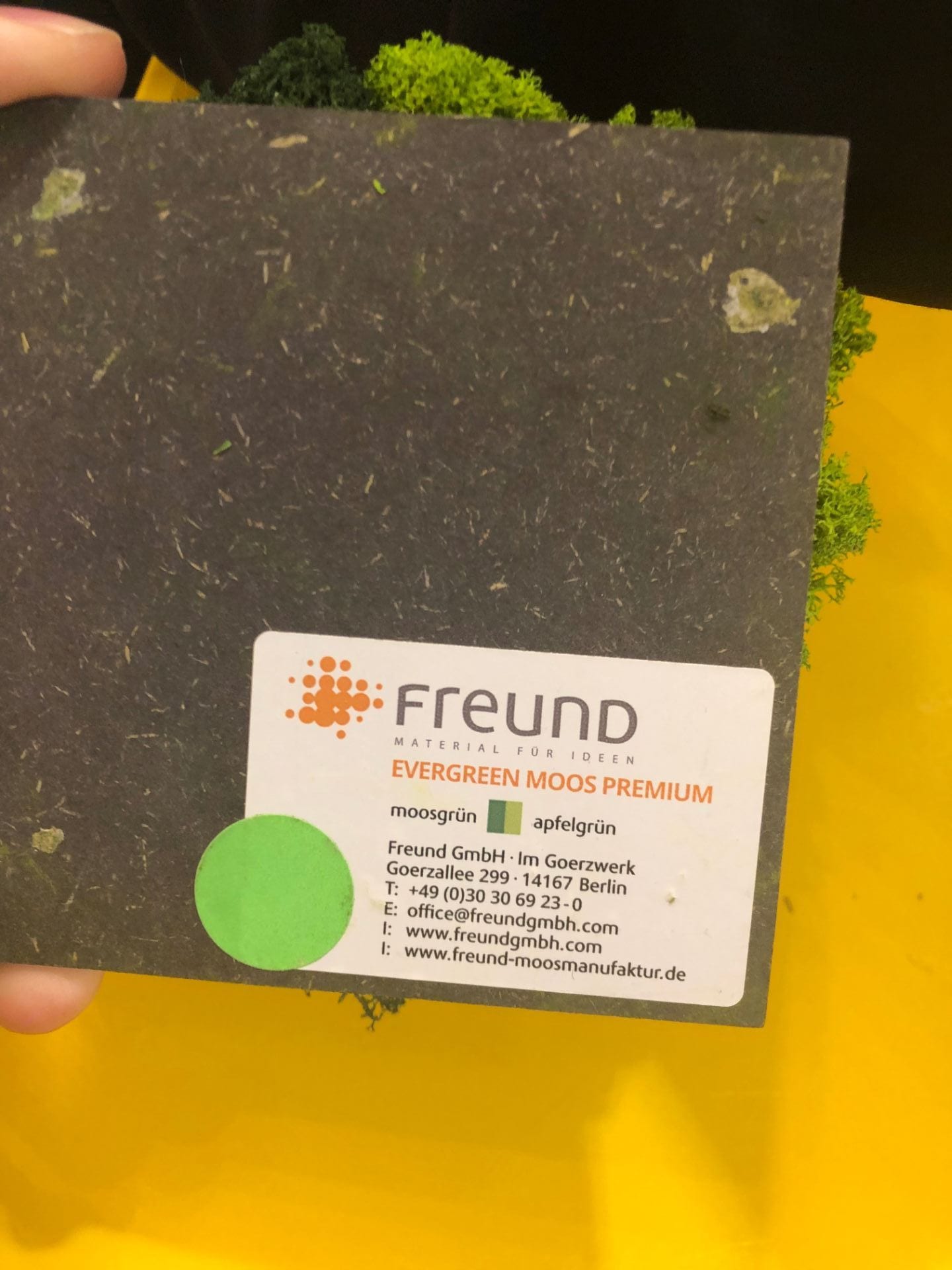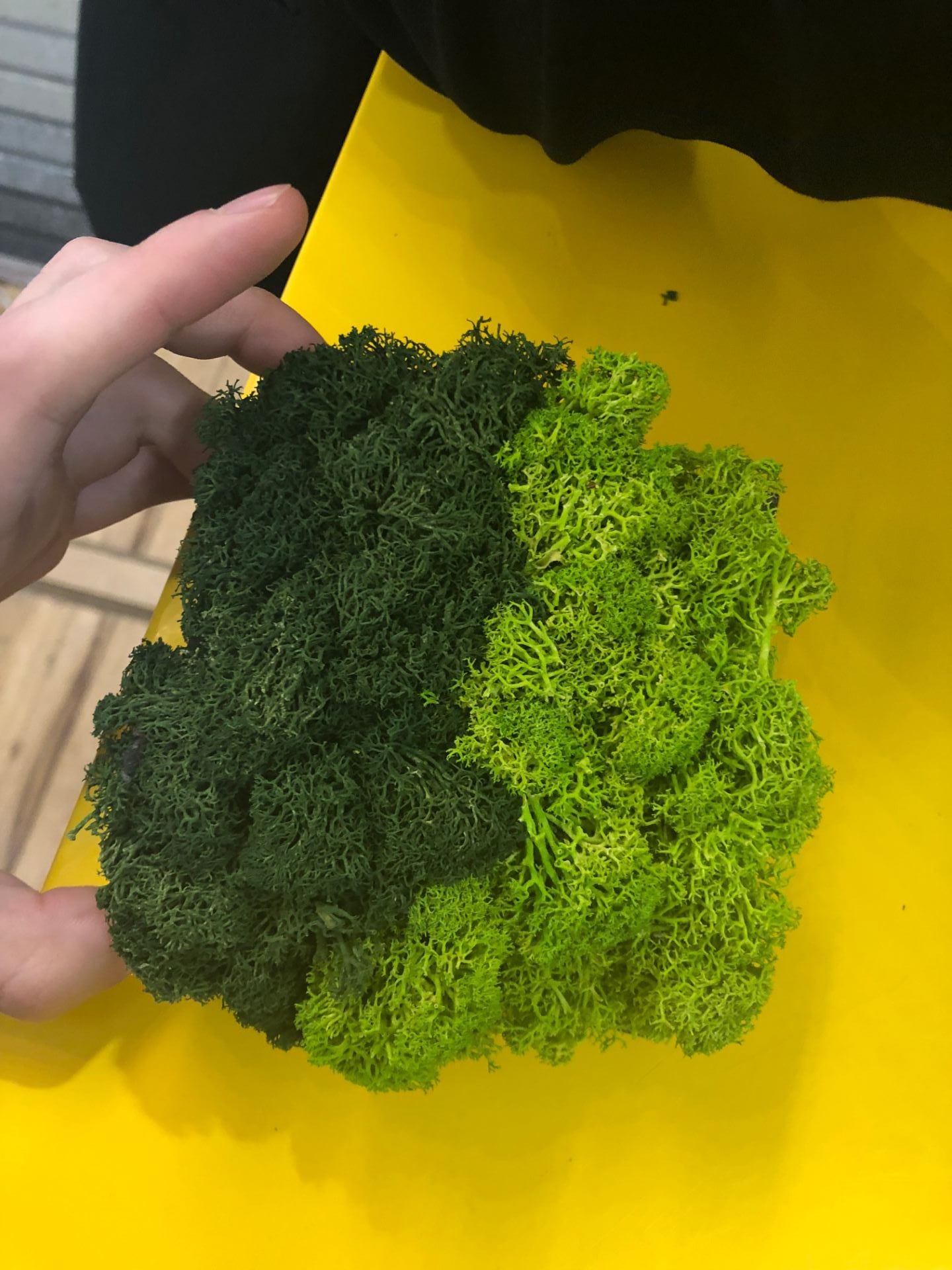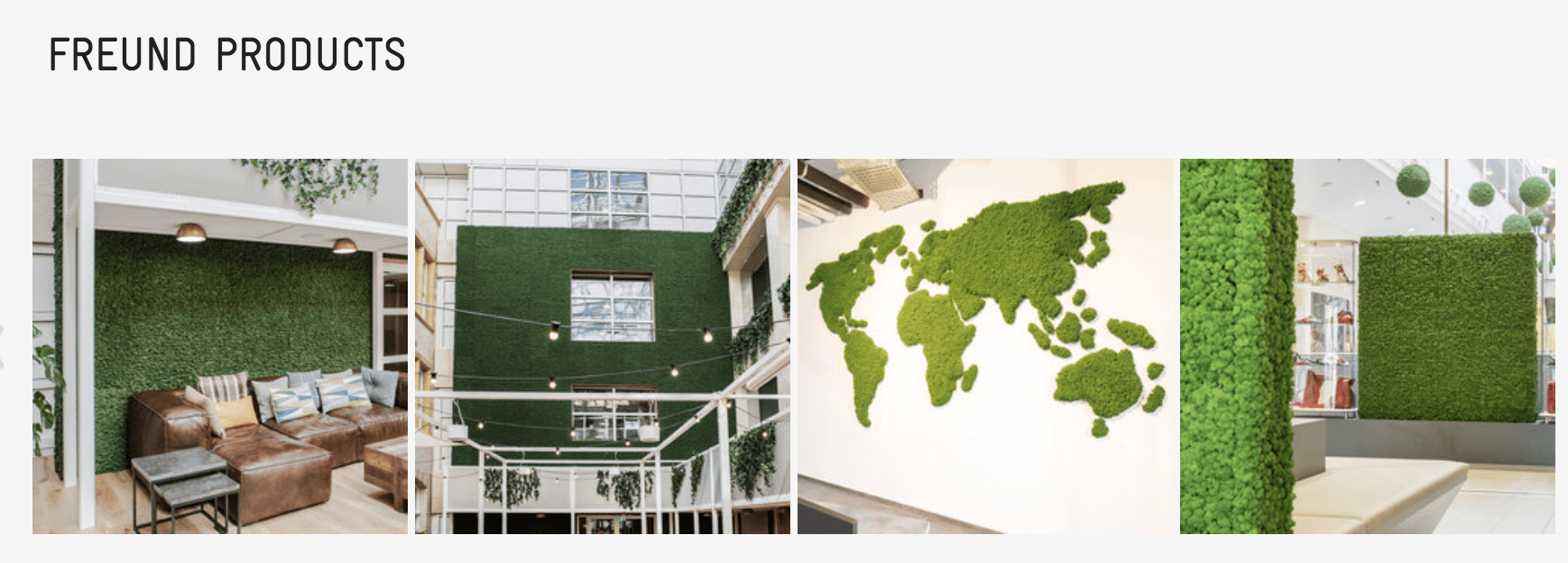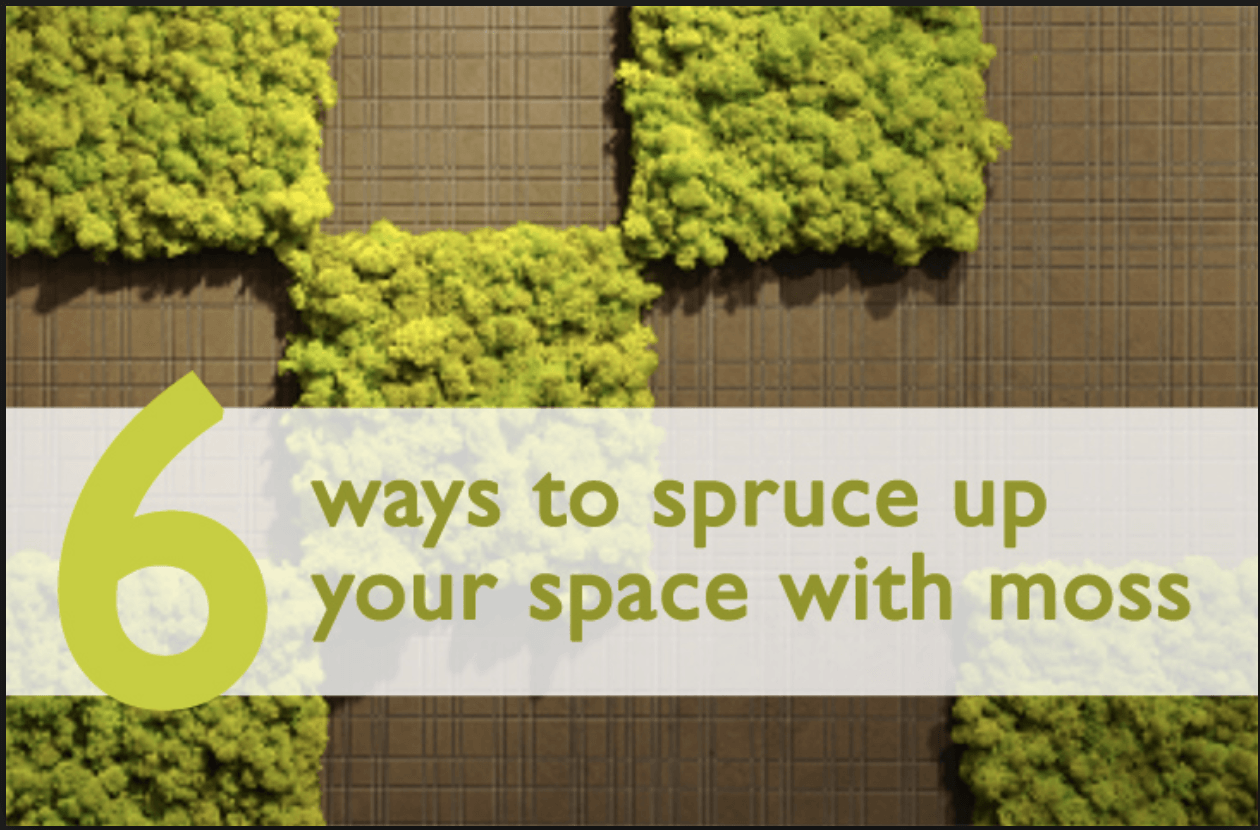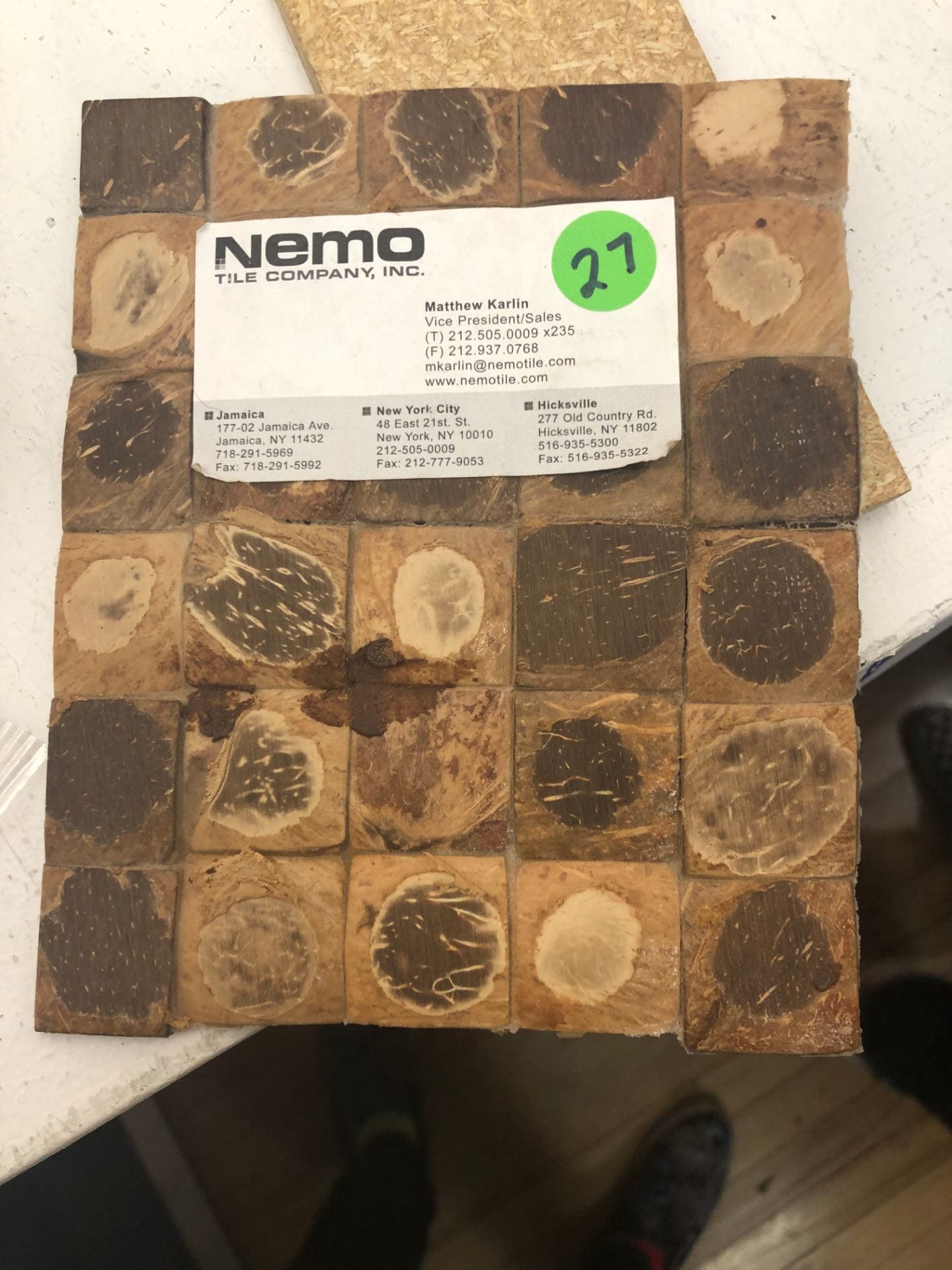During class time last week we took a trip to the materials lab in the Parsons building better to get a grasp of the materiality aspect of the life cycle and longevity of items and how their and the people around them comparison other items in the industry. As designers it’s imperative that we self-critical of the materials we use due to its effect on the environment and the people around them. We looked to three items to do research on to better understand grasp its use and implementation in today’s world.
First item chosen was a mycelium panel. It’s a bio organic based substitute that was created by the company, Evocative. Currently it’s being produced in the US. When looking at it in the material lab it had a spongy material like texture but still held it shape and was rather course. It came in a small Square shaped panel as seen that it had been used as a sample. At first I was curious about picking mycelium as my topic as the manufacturers were able to take a substance that was once living and turn it into a shape that held its form. Mycelium is an important substance and I feel like people are just barely tapped the organism. The reason why mycelium is so adaptable is and how fast the item can grow and reproduce. Mycelium is a mushroom based fungi that grows indefinitely and can reach extremely large sizes. Overall it’s extremely adaptable and easily harvested and that’s why I was interested in it. When looking at steps on how the item is produced it goes through a rigorous growing process where once the fungus is harvested. It is put through a cycle of hydration and cleaning before enough organic matter is finally accumulated and it can be transformed into a strong enough substrate that can hold its own on composition.
In terms of the life cycle this item. It is extremely versatile right now but still the product has some way to go before it’s 100% ready. I feel like right now the potential still untapped due to the fact that the use of mycelium as a product it Is still relatively new. Lately I’ve seen more and more articles pop-up people using this fungus as a product. But it hasn’t really seen much commercial use yet as a day-to-day item. Just last month a breakthrough was made on how to better synthesize the product. So as you can see it’s still on its dormancy state when it comes to untapped potential.Mycelium is the threadlike, vegetative part of a mushroom, and the process of engineering involves using it as an adhesive. Ecovative Design uses mycelium as a bonding agent to hold together wood particles for paneling, as well as for a durable, flame-retardant, and lightweight packaging (National Geographic Society) furthermore the product can also be used as a sound dampener inside a studio due to its ability to absorb sound. Also a local company Manhattan was using the product as a packaging tool has a more sustainable replacement for foam.
1. Name of material
-Mycoboard
2. Manufacturer / Company
-Evocative
3. Country / Place (town, state, city) of Origin
-USA can be sold in NY
4. Describe the general material qualities
-spongy like material that can be sold brick from but is easily broken
5. List the main applications/uses
-Sound insulation
-packing items
-cork for wine bottles
-insulation
-stuffing for chairs
In terms of sustainability. Mycelium right now takes the cake it’s been pretty non-toxic to process the material I’m their not a lot of chemicals used in the manufacturing of it and There’re a lot of practical uses of the product and most of them Count as a substitute. Due to the fact that it can be used as a replacement for plastics. Mycelium is biodegradable but can hold up for a while before it goes bad. It can be used as padding and their other practical uses for me the strong point of the material is how it can be use as a substitute for example in a sound proof room mostly Styrofoam padding is used. To be able to replace it with a more organic substitute would be a great improvement. Furthermore as someone that gets a lot of packages from day today I can see the devastating effects of how much plastic I waste when I get packages and I need to unpack it so to find a biodegradable substitute that can work in its place is far less harmful and then the alternative. In terms of cradle-to-grave the product first and foremost it is mainly equal friendly and if you were just throw it out in your yard eventually we’ll turn back into the dirt. This is a big bonus for the product as a large and for the laws of the conservation of mass the product is made from an already naturally occurring item that can be found all over the world. This means that it’s not man-made or artificial which is another bonus a huge problem people face is the synthetic made materials that need other solvents to break it down and can take thousands of years to decompose naturally. With the use of mycelium all of these problems can be broken down.
One last thing about the product is that right now it as stated previously scientists are just starting to uncover how it can be used. Another bonus feature is it can be mixed with wood chips to strengthen the overall design and make it a stronger material as a whole. But in terms of materiality it’s still largely unknown maybe in the future can be used as biofuel. Right now it is seen as a very suitable substitute for the synthetic polymers used for packaging and other items. And anything that is grow naturally and uses a product is always a positive overall I enjoyed seeing this material in the material lab and it peaked my interest that’s why I chose it as my item
The next item I chose to do research about was a plant-based moss created by the company Freund, Material for Ideen this is a German based company that creates moss. When first looking at the peace it’s composed of a solid brick and then the substrate of moss is growing on the top of it. I’ve always loved plants growing up anything that has grown in abundance has always peaked my curiosity. My still have my large collection of bonsai trees but I enjoy watering from day today. So I saw the opportunity to do research on moss I had to chose that topic !
When looking at applications and uses for the item I looked at the website for primary information and the website seemed to show the Moss primarily for decoration a lot of florists seem to like to use the moss for decoration. It’s a great way to make a bland environment seem closer to nature. Another key use that I found while doing research was Moss could be used as biofuel. This is because it grows in large quantities and is particularly low maintenance to acquire overall because of that it makes for a great use of biofuel. Also another alternative use is it can be used to make whiskey in more unconditional ways. these are some other small uses that I found for Moss while doing research but overall is a very versatile plant. And my interest while looking added in the materials lab. Overall despite my skepticism I was assured that the plan is still alive. It felt organic yet fake when I touched it in the workshop but if what people said were true and the plant is alive it makes for great alternative to decoration anything that is organic I can waste away add be produced is always a good thing in terms of sustainability and lifecycle. This is because as talked about in the mycelium if you use synthetic materials these take forever to break apart but since Moss is organic it makes for great fertilizer once it breaks down completely.
1. Name of material
Moss (Moos Premium)
2. Manufacturer / Company
Archi Tonic
3. Country / Place (town, state, city) of Origin
Germany
4. Describe the general material qualities
Soft life like organic based substance
5. List the main applications/uses
Mainly used for for decor,
fertilizer
bio fuel
below are some examples of uses provided by the manufacturer.
Mosses do not have cells that move water like other plants- water must soak into them, like a sponge. A patch of moss is made of many tiny moss plants packed together so that they can hold water for as long as possible. With That being said they operate differently than other plants. In terms of its lifecycle it is an organic matter and like all organic matter once it dies its cell structure starts to breakdown. As a result I would say it is an environmentally friendly. The reason why I think this does relate to the class in terms of sustainability is because of the fact that once the product is no longer needed you Can still be used as biofuel this was a key point that I pointed out when looking at its lifecycle. First it is easily produced and manufactured. And once it’s served its purpose and is no longer needed it can be reused for fertilizer or biofuel. So in terms of cradle-to-grave it excels there also it has a good shelf life while it is alive.
My only thing I would want to improve on is the diversity of the product. Most Google searches on a superficial level which is what the average consumer would do it just brings out the fact that moss can be used for decorated purposes and leaves it at that I feel like with an organic matter such as this they’re so much more that I can be used for than just decoration so I feel like perhaps be more that we can do with the product overall. With the two products above there isn’t really an issue of obsolescence due to the fact that these items can serve as the substitute. So since it is a different option it doesn’t really get replace so that’s why when talking about that I don’t feel like someone would have to worry about that just yet. In the future I would just want to think about and See. More uses of the moss overall.
For my last material research I chose to look at the Tile company called Nemo. The reason why chose this was because is a local company based in New York and they currently have three locations from what I could find this is why I chose it overall. The piece is a natural wood composite that’s made from the various types of tree. Overall the uses of the material is versatile but because of the logistics of the company and like the other companies they seem to specialize on one thing. When holding the wood in my hand it was extremely firm and solid I couldn’t seem to break it if I tried. this different from the other two materials that I touched due to the fact that the Moss and the mycelium we’re extremely fragile and frail, this wood really juxtapose that. From looking at the company specifically they are a tiling company so it’s primary use is to create floor paneling. But like the other ones I feel like to use is very versatile. In larger quantities the wood give me use for furniture, flooring, Doors, appliances and anything that needs to sturdy foundation.
Overall the wood was cut into multiple small slices and put together within adhesive. Once put together the wood was furnished and shined to give it a good glimmer. Overall the what is still biodegradable but since the nature of the substance it hardens and will last a lot longer than the other two materials discussed. This can prove problematic in the terms of sustainability because it is much longer-lasting then the other two materials. But at the end of the day its all about specifications of the project I say this because the other two items will degrade much faster than the wood. So if you need something taken hold up and stand the test time this is far superior compared to the other two items. And because of that I feel like it does have its positives. Overall there is an is much to say about this in particular due to the fact that’s a specific company that made it only made it for one reason which is for tiling. So my only suggestion an improvement would be to find more ways to make the item sustainable and use it for different applications other than just tiling.
1. Name of material
Tile wood
2. Manufacturer / Company
Nemo
3. Country / Place (town, state, city) of Origin
New York City
4. Describe the general material qualities
Its a hard organic item that has a smooth feel to it. also it seems to be hard to the touch
5. List the main applications/uses
mainly the web-sight listed it at a for decor item
bio fuel
Burning for fire
decor
tiles
roofing
door
In conclusion I chose the motifs of my projects to be things that were naturally occurring in the ecosystem. The three being wood, mycelium and Moss he’s all have a high shelf life but also can be reused enter all biodegradable overtime. None of them really have a negative effect on the environment and can be used as substitutes to their counter. For example the wood can be used to substitute concrete or plastic. And the same goes for the other items to conquer their vices. The only thing for me is the companies that made them were very specific on their uses just because that was the company specialty so overall I looked at it with that lens. So it was harder for me to find examples of uses outside of that area but there are a lot that can be seen in use. Overall what I found from this is most of the time it’s better to use organically I naturally occurring resources over synthetic resources an overall they have a much that are effect on the planet. in terms of sustainability they all have a good life cycle and do a much better job in creating a strong eco system over all.

